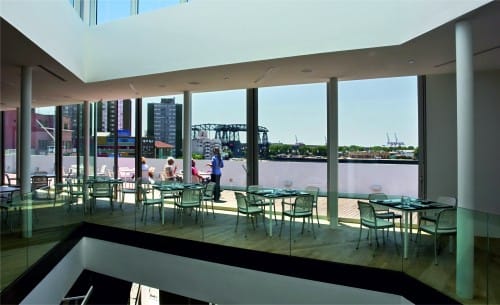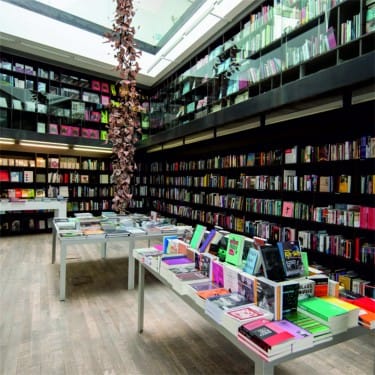The young contemporary Argentinian identity was gestated with a combination of different cultural materials that came through water. Since the late nineteenth century, several immigration currents converged in the historic hood of La Boca, one of the country's most culturally diverse points to this day. The emblematic district is the scene where Proa Fundation is located, a private institution where the past, present and future of the construction of a multicultural Argentinian identity was fed by the river.
Proa Foundation is located at the end of Caminito, a walk of touristy interest characterized by the best years of their port activity. To the sides of the colorful, small city hall, the front wood and plate houses are painted as they used to be by port workers, with traces of paint for tidal rise. The different artistic avant-garde movements of the early nineteenth century transferred by foreign nationalities like the Italians, Spaniards, Greeks, Germans, Genoese and French, influenced several local artistic disciplines. This was reflected, for example, in the work of prolific painter Benito Quinquela Martin, who was able to portray the wonderful everyday landscapes in his neighborhood. With this dichotomy between inside and outside, self and other, local and abroad, the museum's mission, which is to guarantee the circulation of international contemporary art to the public, makes sense.
Ten years after its original opening in 1996, the foundation initiated a process of renovating the building that ended in 2008. The renovation of the space was done by the Italian Caruso Torricell, known for its works in museum, industrial and educational projects. Since then, the space has had three floors. Upon completion of the extension, the museum space was tripled to 2,300 square meters. On the ground floor is the reception area, a hall with lockers for belongings, and three large exhibition halls interconnected by large openings with high walls defining trapezoidal rooms. On the second floor there is another showroom, a multimedia hall for a hundred people, a specialized library where you can find the catalogues of past and present exhibitions, and a multipurpose space with wi-fi. On the third and final floor is a bar where you can sample refreshments on the terrace while enjoying the enviable view of the river and the Nicolas Avellaneda bridge that connects the capital with the province.

The first impression of the aesthetics of the museum in relation to the neighborhood is one of high contrast. Both the postmodern architectural style that retains the original features of the neoclassical facade and the industrial palette and sober materials are disruptive to the overall image of the area. However, the indoor-outdoor relationship is fused by glass panels that allow you to visualize what's going on on the other side at a glance. Once inside, the feeling is similar to entering a space from another world; a world of concrete, glass, light and silence. The exposition salons are spaces that enable the environment of each artist to take over every nook and build its own narrative. The largest room has preserved iron columns, the only noticeable structural element inside. The ventilation and lighting offer the best conditions for the preservation and exhibition of the works according to the demands of the world's best museums. Access to the second floor is granted by stairs overlooking the exterior, where the last room and library contain a large table and chairs that works as a space for curious inquiries, students, artists and researchers. On this same level is the auditorium where movies, video records and multimedia shorts are part of the exhibits on display. The crown of the museum is located on the top floor, where you can delight in the menu offered by the bar and restaurant led by Chef Lucas Angelillo on the warmth of the deck. Summer evenings are a prime time to watch the magical play of light and sunset colors.
Since the opening of the present building, the museum has housed exhibits of works by artists of renown such as Marcel Duchamp, Mark Rothko, Joseph Beuys, Cai Guo-Qiang, Mona Hatoum, Jack Vanarsky and Alberto Giacometti, among others. In February 2004, Proa had a record-breaking amount of spectators, thanks to the attendance of more than 151,000 people who came to see the sculptures of resin, fiberglass, silicone and acrylic painting by Australian artist Ron Mueck. His sculptures captivated audiences through scaling the dimensions and realism of suspended characters, whose gestures subtly expressed situations full of life and decontextualization. A mother with her son, young couples or adults ranging between tension and calm, and a naked man in a drifting boat are some of the images that were part of the sample. In the same way and with the same commitment, Fundacion Proa organizes projects that bring together local artists with international projection, such as Marta Minujin, Alexandra Kehayoglou, Jorge Macchi, Paul Siquier, Ernesto Ballesteros, Marina De Caro and Adrian Villar Rojas.

Since December 12 of last year, they have presented the first ontological showing of the works of Londoner Jeremy Deller (49). Museum facilities allow the enjoyment of the multiplicity of languages explored by the English artist through installations, videos, photographs, and even graffiti. "English Magic" with which he represented the UK at the Venice Biennale 2013 is included. His production realizes the political and social circumstances of contemporary life, while presenting a critique of the art system itself. In 2004 he won the Turner Prize and in 2010 was awarded the Albert Medal of the Royal Society of the Arts. While working with a multitude of media such as video, sculpture and graphics, his work has had an emphasis on collaborative projects, reenactments and public art, from which he reflects on post-industrial British popular culture.
The foundation completes its activity by offering the ability to actively participate in educational programs besides guided tours, projections on the facade, fashion shows and music recitals. All this summer, the invitation is open to the public to participate in the "Nomade Cultural Center" on Proa's sidewalk. It is an old recycled container port, which can be a library, a gallery, or even a theater. Every week brings new proposals that integrate culture and the environment, encourage more responsible awareness of nature through games, and stimulate creativity through expressive experimentation.
The Proa Foundation functions as a cultural metabolic organ that continues the renewal of different contemporary expressive languages, challenging the commonplace and opening new questions about the complexities of the current social paradigm.
